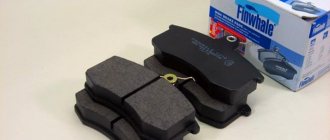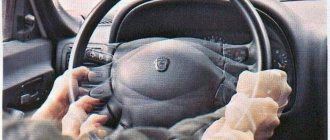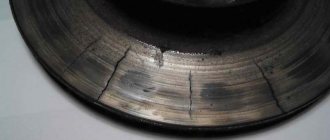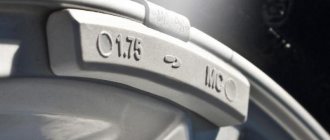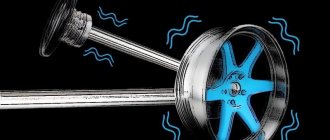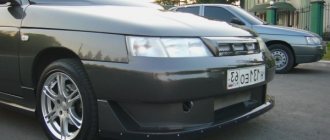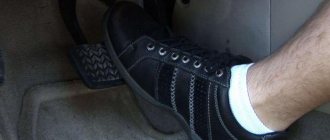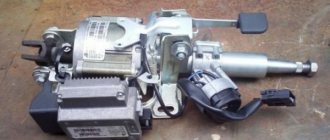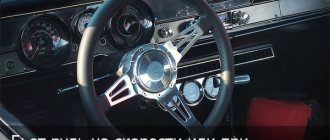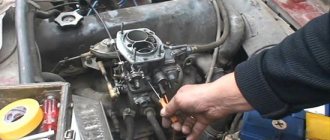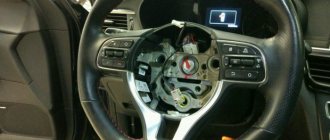Vibration of various elements of the car inevitably occurs during operation, when the moving parts of the chassis and transmission gradually wear out. But among such malfunctions, there is one dangerous malfunction - the steering wheel wobbles when braking. The more the steering wheel jerks after pressing the brake pedal sharply, the higher the likelihood of losing control and flying off the road at a decent speed. To avoid the described emergency situation, it is worth studying the nature of the problem and how to solve it.
Why does the steering wheel vibrate when braking?
Before self-diagnosis, you should think about what preceded the appearance of the beating. Has the chassis system been repaired or brake pads replaced? It is worth starting to identify the breakdown with replaced parts. They may be made from low quality materials.
It is also important to consider the experience of the technician who performed the repair. Failure to comply with installation technology leads to increased loads. Not only the replaced part suffers, but also the system as a whole.
Did the steering wheel wobble after driving through puddles or fresh snow? Pay attention to the condition of the brake discs. Temperature changes lead to surface deformation.
Does the steering wheel exhibit a large range of motion and become difficult to hold? With a 99% probability, the problem lies in broken brake discs or improper bleeding of the system. In such a situation, urgent repairs are necessary. The wheels react differently when you press the brake pedal. The likelihood of getting into an accident increases, and driving the car becomes uncomfortable even for an experienced driver.
Reasons for vibrations in the steering wheel:
- Wear of brake discs.
- Technical condition of the running system.
- Hernia or deformation of the wheels.
- Nuts not tightened tightly.
Before detecting deformation of the steering rod or wear of the brake disc, you should pay attention to the fastening of the wheels. In most cases, the cause of wobbling is not that they are poorly secured. But if the problem is just one loose nut, then it will be unpleasant to find out after a full repair.
Vibrations in the steering wheel/brake pedal
Cause: worn or deformed brake discs.
The brake rotor (disc) is part of the braking system; it rotates together with the wheel. Let us remind you that the wheel is fixed directly to the disk. By pressing the brake pedal, you force the brake pads to press against the brake disc, as a result, the rotation of the discs (and wheels) slows down and the car stops. As you understand, the brake disc is very important for the operation of the car.
Let's try to look at how brake discs work. Almost always discs are made of metal. They are made to a special width, which depends on the manufacturer and model of the machine. When you press the pedal, the pads, on which the abrasive material is applied, rub against the disc, creating serious pressure - the disc ultimately experiences a strong increase in temperature. This, in turn, leads to minor, but still changes in the metal (density changes) - the disk must be cooled over the entire area.
In practice, such cooling does not always occur (and sometimes abruptly), as a result of which a change in density leads to deformation changes only in some places, and the nature of the deformation itself is visible as a wavy surface. Next, this is what happens - if at high speed the pads are pressed against such a deformed disc, then the entire brake caliper begins to tremble, transmitting this vibration to the wheel, which, in turn, sends a beating either to the steering wheel or to the body of the entire car.
A sharp drop in brake disc temperature after pressing the brake pedal for a long time can be caused, for example, by snow or running into a puddle.
The common people often hear the phrase “disc led” - it just means the deformed surface of the brake disc. An additional sign, coupled with vibration, indicating deformation of the disk surface is a bluish tint of the metal on the disk, which is also a consequence of overheating.
It is very easy to diagnose a disk for deformation. You will need to jack up the wheel. In this case, the handbrake must be removed, the gear must be put in neutral (make sure that the car does not roll away). Then, in this state, spin the wheel - rotation should be easy and without jamming. An abnormally fast stop of the wheel or “heavy” rotation at a certain point most likely indicates damage to the brake disc.
If a car uses discs not only at the front, but also at the rear, the latter can be diagnosed by using the parking brake while braking. If you also feel a beating when you move the handle towards you, then the culprit is most likely the rear disc.
If it is the disc in front that has a deformed surface, you will feel a beating that radiates directly to the steering wheel. If the rear disc is to blame, then vibrations, in principle, may not be felt (except for severe deformation of the disc; in this case, at high speeds, shaking during braking is still felt). The vibration felt in the brake pedal does not clearly indicate whether the disc is warped at the front or rear.
How to detect wear on brake discs?
Before repairing, it is necessary to diagnose the breakdown. Is it just the steering wheel that vibrates? The likely cause is wear of the front brake discs or the system as a whole. Has the brake pedal also changed its behavior? Pay attention to the rear braking system.
The handbrake can be used to determine the malfunction. If the vibration stops when using it, then you should look for a problem in the front brake system. Is there any beat left? Examine the technical condition of the rear brake discs and the system as a whole. The procedure allows you to determine the location of deformed parts.
Next, you should test the wheels or study the appearance of the brake discs. Raise the car on a jack and remove it from gear. If the rear axle is suspected, then the handbrake must be lowered. Spin the wheel. Is the rotation uneven and changing intensity in the same place? The problem has been identified. If the test result is negative, move on to the next wheel.
The appearance of the brake disc says a lot about its technical condition. Noticed cracks, unevenness or chips? Replacement or grooving is required, depending on the situation. The presence of a bluish tint on the surface is a sign of overheating.
When inspecting, pay attention to the brake calipers. It's unlikely, but they can also cause vibrations in the steering wheel.
Other causes of vibration
Steering wheel vibrations that are not associated with the car jerking in different directions appear for the following reasons:
- One of the vehicle's process fluids, for example, transmission oil, got on the pads as a result of oil seal wear. Possessing significant viscosity, the lubricant adheres well to any surface and disrupts the normal operation of the brakes when the pedal is pressed sharply.
- The internal elements of the steering rack have worn out, and significant play has appeared.
- The steering rod ball pins have become unusable.
- Inoperability of shock absorbers and front struts. Vibration on the steering wheel is felt when braking sharply and at the same time entering a turn.
Note. Problems associated with wear of ball joints and shock absorbers also appear on the wheels of the rear axle. Most often, brake fluid gets on the pads, the reasons are faulty working cylinders and leaky rubber cuffs.
A strong side impact of any wheel on a high curb (for example, due to ice or an accident) can lead to deformation and subsequent vibration. The main load is taken by the disk, wheel bearing and various suspension joints. Any of the listed parts can become cracked and cause the steering wheel to vibrate during braking.
How to determine wear of the chassis and other breakdowns?
Is the failure at the front, but the tested discs are in perfect condition? A visual inspection of the chassis system allows you to find a breakdown. Tie rods and ends are likely causes of steering wheel wobble.
It will be difficult for an inexperienced person to notice the deformation of the structure. But if you notice unnatural bends, then the reason for the vibrations becomes clear. In less severe cases, it is necessary to rely on inspection and evaluation of the system as a whole.
A herniated or deformed tire is easily detected visually even by an inexperienced driver. There shouldn't be any problems with this. If there is no visible damage, it will be useful to remove the wheel and examine the surface from the inside.
Vibrations sent into the steering wheel after changing the disc, hub or bearing
If you notice that vibrations reverberating through the steering wheel or body of the car were detected after work was carried out in a car repair shop, then you need to look for the cause of this misfortune there. Such shaking could be caused by a previous change of the brake disc (as well as the hub bearing or the entire hub), which from time to time causes the steering wheel to shake. Usually this happens due to low-quality replacement elements, although coupled with this is an irresponsible attitude towards the procedure for replacing parts. The disk could have been tightened with the wrong force, or the disk could have been installed crosswise without tightening. The torque that should be applied to tighten is often indicated directly on the disc.
If runout on the steering wheel or body of the car was detected after operations on the chassis of the car, try to involve the same specialist who performed these operations on the chassis.
How to solve the problem with vibrations in the steering wheel?
When brake discs wear out, there are 2 ways to solve the problem. Grooving and replacement. By changing an element of the system, you can forget about the steering wheel beating for a long time. Grooving allows you to get rid of vibrations and keep your budget safe. But the working life of the disk will decrease and a repeat procedure may soon be required.
It is recommended to replace on both sides at the same time. This way you will achieve the best effect and eliminate steering wheel beating.
Deformation of the steering rod, ends, brake calipers - replacement of the part that has become unusable is mandatory. Actions to give the spare part its original technical characteristics are doomed to failure. The effectiveness of such measures is extremely low.
In situations with tire damage, everything depends on the degree of wear and experience of the technician. Often the problem is resolved quickly and without undue burden on the budget.
How do brakes work?
When you press the brake pedal, a chain reaction begins. Brake fluid is pumped, driving the brake calipers. When fluid is applied to the caliper, the brake pads inside the calipers compress the surface of the disc brake (rotor), clamping them onto the surface of the disc brakes. As a result of the friction of the pads on the surface of the brake discs, they slow down (and the wheels) and ultimately stop the car.
Because disc brake rotors are mechanically connected to the wheels and suspension system, any vibrations during braking travel up the steering wheel, where the driver feels them.
see also
The main causes of car shaking when braking
Why are vibrations in the steering wheel when braking dangerous?
In most cases, the breakdown does not require immediate repair. By eliminating emergency braking, the car can be used even for several years. But there is an increased load on the chassis system, it is important to realize this.
By refusing to make repairs, you may end up having to spend a lot of money in the future. An important aspect is the pleasure derived from driving a car. The vibration of the steering wheel does not allow you to fully enjoy the trip.
The optimal solution in this situation is to carry out repairs if funds are available. The problem does not require urgent replacement of parts. But by constantly postponing repairs, you reduce your comfort and increase its cost.
Main reasons
Experts identify several main reasons why a car hits the steering wheel when braking. And there are appropriate ways to solve these problems.
Here it is worth focusing attention on such points.
- New low quality parts. Think and remember why similar manifestations on the steering wheel occurred. It is possible that vibrations appeared precisely after the repairs were carried out, when brake discs and pads were changed, or interference was made in the design of the chassis and suspension elements. If vibrations become noticeable just after the repair, then newly installed parts become potential suspects. They may be of low quality, a factory defect, or simply not suitable for your car.
- Low level of qualification of the master. This is not exactly the reason, but it also needs to be taken into account. Insufficient experience of the repairman who carried out the repair can provoke similar symptoms on the car. The technology was broken, and therefore now, until the problem is eliminated, the symptoms will not go away.
- Brake discs. Also, the reasons may lie in driving through cold puddles or snow. If you notice that the steering wheel shakes when braking after this, it appeared precisely after traveling, check the condition of the brake discs. When faced with sudden temperature changes, becoming very hot and then immediately cooling, the discs can become deformed.
- Also, a malfunction of the brake discs is indicated by vibration with a large amplitude and a feeling that the steering wheel has become more difficult to hold. Here the reason may lie in the brake discs themselves, or in incorrectly performed bleeding of the brakes after repair or service.
- Problems with the chassis. This is why the steering wheel potentially shakes even when braking. You will need to diagnose the chassis and try to detect the faulty component.
- Hernia and deformation of the wheel. Sometimes this is not so easy to notice if the change in wheel geometry is minor. But if it is present, it will be reflected in the behavior of the car during acceleration and braking.
- Wheel nuts. The reason is banal. These are poorly tightened fasteners. They are often advised to be checked first. The cause often goes unnoticed, and drivers spend a lot of money and time on diagnosis.
There are more than enough potential reasons. And each of them can potentially create serious problems for the car owner.
If you notice the first signs of vibrations in the steering wheel, be sure to go to the garage for independent diagnostics and repairs, or contact a car service center for help.
It is strictly not recommended to delay repairs if such symptoms occur.
Troubleshooting Methods
When the steering wheel of a car constantly shakes when the driver presses the brake, you cannot put up with this state of affairs. The problem should be resolved as soon as possible.
The actions of the motorist largely depend on what kind of malfunction we are talking about.
- If the brake discs or drums are worn out, the problem can potentially be solved in 2 ways. This is the replacement of worn elements, or their grooving. If you make a replacement, the beating will go away for a long time. Grooving is a temporary measure, but it can save you money. The effectiveness and longevity of brakes after grinding is very unpredictable. Much depends on the condition of the knot and the skill of the one who will sharpen them.
- When replacing brake system elements, especially drums, discs and pads, it is recommended to install new elements simultaneously on both sides of the front or rear axle. That is, when the rear left brake disc is replaced, a new rear right disc must be installed in parallel. The state of the second does not matter.
- In case of damage to the calipers, steering rods and tie rod ends, only replacement helps. These elements cannot be repaired or restored. Any attempt at restoration can result in serious consequences.
- Damage to tires and wheels can be eliminated by replacing or restoring them. Much depends on the level of deformation and complexity of the restoration.
Whenever possible, try to replace parts rather than rebuild them. Restoration gives only a temporary effect, and the car’s behavior becomes more unpredictable.
Many people underestimate the danger of vibrations on the steering wheel when braking. And this is a very common mistake.
Serviceable brake system and pedal beats
If the braking system is fully operational, but vibration is still felt during braking and no defective elements can be detected, then the problems are hidden in less obvious places.
It is recommended to carefully check the reliability of the body, suspension and braking system. Service station specialists often find poorly tightened bolts throughout the vehicle. This problem will be especially relevant if the car is often used on roads of poor quality.
Deformations in drum brakes
Drum brakes are practically not subject to deformation, but sometimes troubles can happen to them. They, like disk ones, can overheat (but to a much lesser extent). Overheating occurs if, in a hurry, the driver forgets to release the handbrake and at the same time drives a fairly long distance. The driver may not notice that the car is practically not moving. When stopping, the handbrake remains raised, or the handbrake is pulled again.
